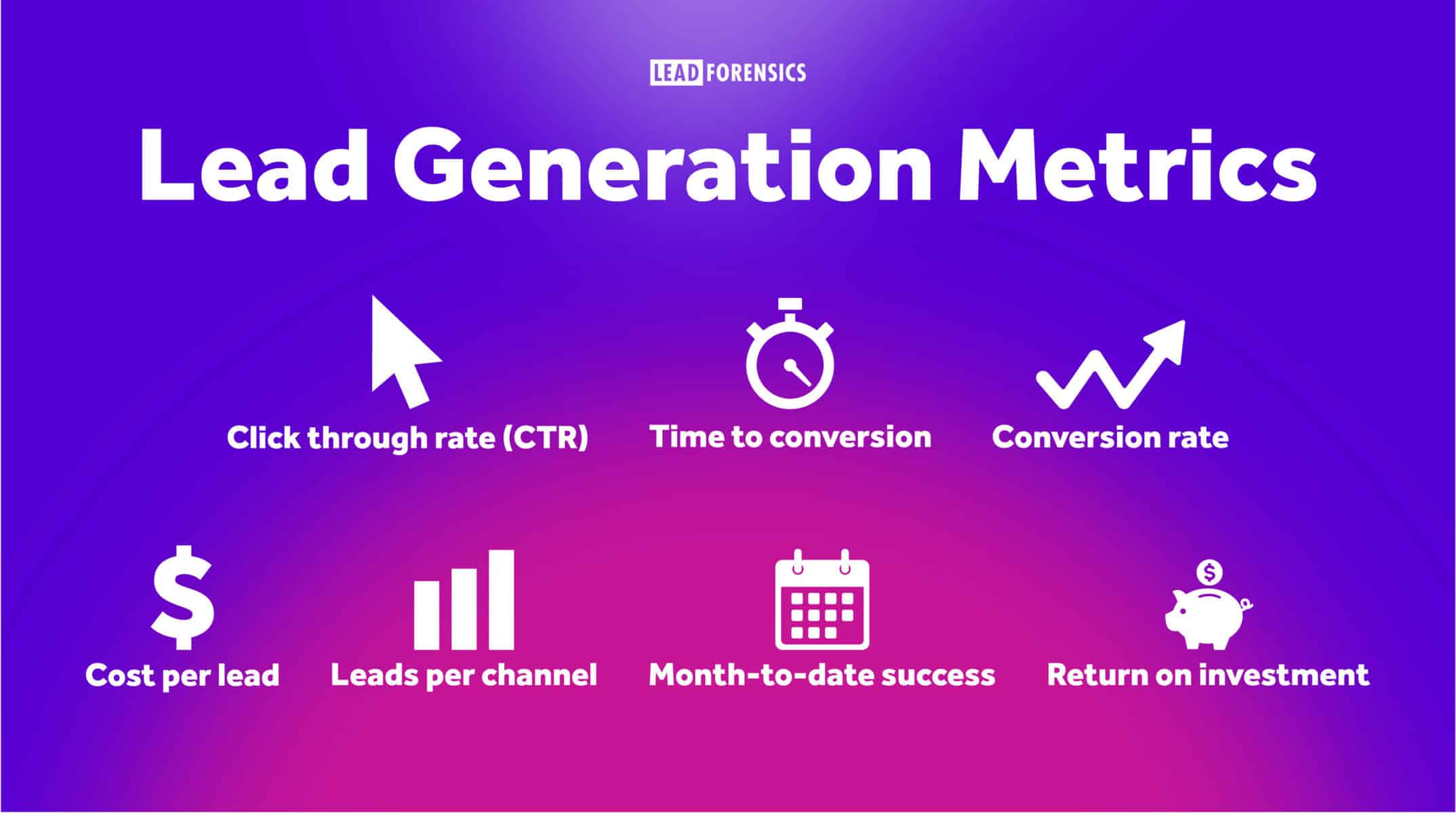Measuring SEO Success with Lead Generation Metrics
In today's complex marketing landscape, lead generation stands as a vital element for businesses striving to succeed in competitive markets. Yet, generating leads is just the beginning; understanding and optimizing this process is crucial for sustained growth.
This article explores lead generation metrics, highlighting the importance of tracking and analysing key performance indicators (KPIs) to gauge success accurately. By examining these metrics, businesses can assess the effectiveness of their lead generation strategies, pinpoint areas for improvement, and ultimately boost their profitability.
Let’s delve into the metrics that drive successful lead generation!
Why measure success?
It’s necessary to measure how effective your lead generation efforts are in today's competitive market landscape. It provides tangible insights into the effectiveness of your marketing channels and campaigns.
By analyzing these metrics, businesses can pinpoint which initiatives are driving meaningful engagement and which ones are falling short. Measuring lead generation success enables companies to align their marketing efforts with overarching business objectives.
Whether the goal is to increase brand awareness, drive sales, or expand market share, tracking relevant metrics ensures that marketing strategies are tailored to deliver desired outcomes.
Detailed measurement allows for optimization and refinement of lead generation tactics. By identifying underperforming areas or channels, businesses can allocate resources more efficiently and focus on strategies with higher conversion rates and returns on investment.
In today's dynamic market environment, consumer behaviors and preferences can change rapidly. Regularly measuring metrics enables businesses to stay agile and adapt their strategies to evolving trends, ensuring continued relevance and effectiveness.
Conversion Rate
Conversion rate is a pivotal metric in lead generation. It represents the percentage of website visitors or leads who take a desired action, such as making a purchase, filling out a contact form, or subscribing to a newsletter.
It serves as a barometer of how effectively a business is turning leads into customers or achieving other predefined goals. In order to calculate the measure, divide the total number of leads or visits by the number of conversions, then multiply the result by 100 to obtain the percentage.
Jessica Shee, Marketing Manager of M3 Data Recovery said a high conversion rate indicates that a business's marketing efforts are resonating with its target audience and compelling them to take action. Conversely, a low conversion rate may signify that there are barriers preventing leads from completing the desired action, such as a complicated checkout process or unclear call-to-action buttons.
To enhance conversion rates, businesses can employ various strategies, including optimizing website design for user experience, streamlining the checkout process, creating compelling and relevant content, implementing persuasive calls-to-action, and conducting A/B testing to identify which elements resonate best with their audience.
By continually monitoring and optimizing conversion rates, businesses can refine their lead generation strategies, increase the effectiveness of their marketing efforts, and ultimately drive more conversions and revenue.
Cost per Lead (CPL)
Cost per lead (CPL) is a fundamental metric that measures the average cost incurred by a business to acquire a single lead. It is calculated by dividing the total cost of lead generation efforts by the number of leads generated within a specific period.
Andrew Johnson, Digital Strategist of Giveaways said, CPL provides insights into the efficiency and effectiveness of a business's marketing campaigns. By determining how much it costs to acquire a lead, companies can evaluate the return on investment (ROI) of their lead generation activities and allocate resources accordingly.
A low CPL indicates that a business is acquiring leads at a relatively low cost, maximizing the value of its marketing budget. A high CPL may suggest inefficiencies in lead generation tactics or excessive spending on acquisition channels that do not yield desirable results. To lower CPL, businesses can employ strategies such as optimizing advertising campaigns to target more qualified leads.
They can also improve landing page conversion rates and enhance lead nurturing efforts to increase lead-to-customer conversions. Negotiate better rates with advertising platforms or lead-generation partners. By actively monitoring and optimizing CPL, businesses can streamline their lead generation processes, improve marketing efficiency, and achieve a higher ROI.

Lead Quality
Lead quality refers to the relevance and suitability of leads generated through marketing efforts. It assesses the likelihood that a lead will convert into a paying customer or take other desired actions that align with business objectives.
It is not solely determined by the quantity of leads generated but also by their characteristics and behavior. High-quality leads typically exhibit attributes such as genuine interest in the product or service, alignment with the target audience demographics, and a willingness to engage with the brand.
Focusing on lead quality is essential for maximizing the efficiency of sales and marketing efforts. Quality leads are more likely to convert into customers, resulting in higher conversion rates, increased revenue, and a better return on investment (ROI). Moreover, prioritizing lead quality helps avoid wasting resources on leads that are unlikely to result in meaningful outcomes.
Businesses can assess lead quality through various methods, including analyzing lead demographics, tracking engagement metrics such as website interactions and email opens, and implementing lead scoring systems to prioritize leads based on their likelihood to convert.
To improve lead quality, businesses can refine their targeting strategies to attract leads that closely match their ideal customer profile, personalize marketing messages to resonate with specific audience segments and implement lead nurturing programs to cultivate relationships with leads over time.
Lead-to-Customer Conversion Rate
The lead-to-customer conversion rate measures the percentage of leads that ultimately become paying customers. It is a critical metric that evaluates the effectiveness of a business's sales and marketing efforts in converting leads into revenue-generating customers. It quantifies how successful a business is at moving leads through the sales funnel and converting them into customers. It indicates the efficiency of the sales process and the alignment between marketing efforts and sales goals.
Manobal Jain, founder of Trainerfu said, a high lead-to-customer conversion rate indicates that a business is effectively nurturing and qualifying leads, resulting in a higher return on investment (ROI) for marketing efforts. Conversely, a low conversion rate may signify inefficiencies in lead nurturing, sales follow-up, or targeting strategies.
Lead-to-customer conversion rate is calculated by dividing the number of leads that convert into customers by the total number of leads and multiplying by 100 to get a percentage. For example, if a business converts 100 out of 500 leads into customers, the conversion rate would be 20%.
To increase lead-to-customer conversion rates, businesses can implement strategies such as optimizing the sales process to reduce friction and improve the customer experience, providing targeted content and offers to leads at different stages of the buyer's journey, and leveraging customer relationship management (CRM) systems to track and nurture leads effectively.

Return on Investment (ROI)
Return on investment (ROI) is a fundamental metric that evaluates the profitability and effectiveness of an investment relative to its cost. In the context of lead generation, ROI measures the financial return generated from marketing efforts compared to the resources invested in acquiring and nurturing leads.
ROI provides insights into the success and efficiency of lead generation activities by quantifying the financial returns generated from converting leads into paying customers. It allows businesses to assess the profitability of their marketing campaigns and make data-driven decisions about resource allocation and strategy optimization.
Elisa Bender, SEO Strategist of RevenueGeeks said a positive ROI indicates that a business's lead generation efforts are generating more revenue than the cost incurred to acquire and nurture leads, resulting in a profitable return. Conversely, a negative ROI suggests that the investment in lead generation is not yielding the desired results and may require adjustments to improve efficiency and effectiveness.
ROI is calculated by subtracting the cost of lead generation activities from the revenue generated from converted leads, dividing the result by the cost of lead generation, and multiplying by 100 to get a percentage. For example, if a business spends $10,000 on lead generation activities and generates $50,000 in revenue from converted leads, the ROI would be 400%.
To maximize ROI from lead generation efforts, businesses can focus on optimizing conversion rates, reducing the cost per lead, improving lead quality, and enhancing lead-to-customer conversion rates. Leveraging data analytics and performance tracking tools can also help identify areas for improvement and inform strategic decision-making.
Quantify Your Success
Lead generation metrics play an important role in guiding businesses towards success in today's competitive landscape. By diligently tracking and analyzing metrics, companies can gain valuable insights into the effectiveness of their efforts. Continuous monitoring and optimization of these metrics enable businesses to refine their strategies, maximize efficiency, and drive sustainable growth.
In the dynamic world of lead generation, embracing data-driven decision-making is paramount for staying ahead of the curve and achieving long-term success. Which metrics do you measure for your lead generation efforts? Talk to us in the comments below!
Conclusion
In conclusion, learning supereminent generation criteria is essential for businesses aiming to thrive in moment's competitive request. By constantly tracking and assaying crucial criteria , companies can gain perceptivity into the effectiveness of their strategies, optimize their sweats, and achieve sustainable growth. Prioritizing data- driven decision- making allows businesses to upgrade their approaches, enhance conversion rates, and maximize return on investment, icing long- term success in supereminent generation.





